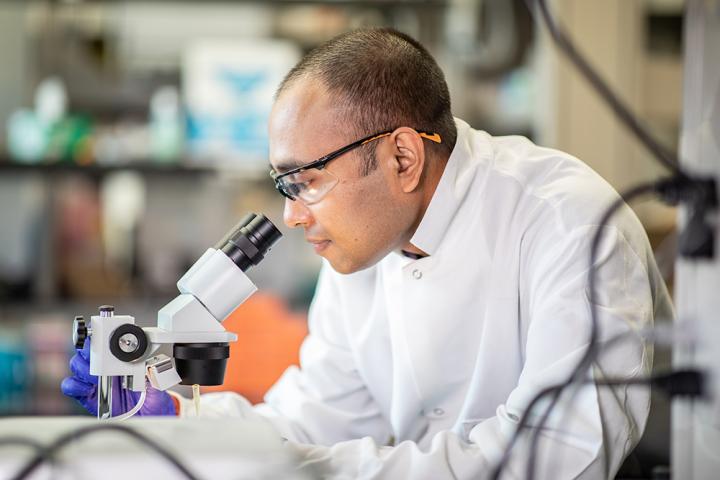Team identifies crucial interaction between platelets and tumors for the first time

Credit: Texas A&M Engineering
In the evolving field of cancer biology and treatment, innovations in organ-on-a-chip microdevices allow researchers to discover more about the disease outside the human body. These organs-on-chips serve as a model of the state an actual cancer patient is in, thus allowing an opportunity to finding the correct treatment before administering it to the patient. At Texas A&M University, researchers are pushing these devices to new levels that could change the way clinicians approach cancer treatment, particularly ovarian cancer.
The team has recently submitted a patent disclosure with the Texas A&M Engineering Experiment Station.
“We claim several novelties in technological design as well as biological capabilities that didn’t exist in prior organs-on-chips,” said Dr. Abhishek Jain, lead researcher and assistant professor in the Department of Biomedical Engineering.
Jain also has a joint appointment in the College of Medicine at Texas A&M.
Jain’s device — the ovarian tumor microenvironment-chip (OTME-Chip) — focuses on platelets, tiny blood cells that help the body form clots to stop bleeding. The microdevice, about the size of a USB, models the properties of a tumor in the lab. Researchers then can recreate events within platelets circulating in the blood as they approach the tumor and make it more potent and metastatic.
“We are creating a platform technology using the organ-on-a-chip approach where tumor biology can be advanced, and new drugs can be identified by recreating the platelet-tumor and platelet-tumor-drug interactions under the influence of flow, supporting blood vessels and the extracellular matrix,” Jain said.
Ovarian cancer is a particularly challenging one to monitor. Tumors generally form deep inside a patient’s tissue, and it can be difficult to obtain real-time information of the tumor’s properties and how it is interacting with blood cells. Also, ovarian tumors can quickly spread inside the body, making time another vital factor in mapping the disease’s progression.
The OTME-Chip builds on the current clinically observed understanding of how blood platelets move inside tumor tissue and what triggers them to spread outside the tumor. However, the actual mechanism behind this process remains mostly unknown, until now.
“For the first time, we identified a crucial interaction between platelets and the tumor via their surface proteins,” Jain said. “By applying high-resolution imaging, advanced cell and molecular readouts and RNA sequencing methods leveraging the OTME-Chip, we discovered the actual genetic signaling pathways behind the blood cell triggered metastasis of ovarian cancer and a new drug strategy to stop this process.”
Jain’s team in College Station for this research includes postdoctoral researcher Dr. Biswajit Saha and doctoral students Jim Tronolone and Tanmay Mathur. Their research involving the OTME-Chip was recently published in the journal Science Advances.
Jain said the OTME-Chip has several applications, both in observing how cancer cells interact differently with vascular and blood cells and testing novel ways to treat the disease that may complement chemotherapy and radiotherapy of tumors.
“This multimodal OTME-Chip is going to provide an ideal platform to the health care researchers to evaluate their anti-cancer, vascular and hematological drugs individually or in combination in an artificially created human-level tumor microenvironment,” Jain said.
Jain collaborates with Dr. Anil Sood, professor and vice chair for translational research in the Departments of Gynecologic Oncology and Cancer Biology at MD Anderson Cancer Center. The team also works with Dr. Gang Bao, a gene editing expert from Rice University.
“Sood is a leader in the ovarian cancer field,” Jain said. “He has been a fantastic collaborator and has provided us access to patient tissue and blood samples needed to validate the findings from our chip, which brings us very close to initiating new clinical trials.”
###
This research is funded through grants from the National Institutes of Health, the National Science Foundation and the Texas A&M President’s Excellence Fund.
Video link: https:/
Video caption: This clip shows how the ovarian tumor microenvironment-chip (OTME-Chip) allows researchers to view cancer cells, blood vessels and platelets outside the body.
Video credit: Dr. Abhishek Jain/Texas A&M Engineering
Media Contact
Amy Halbert
[email protected]
Original Source
https:/
Related Journal Article
http://dx.




